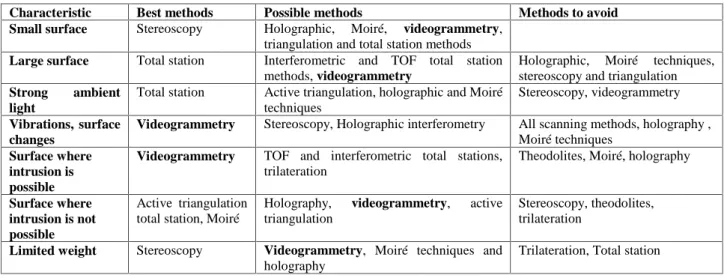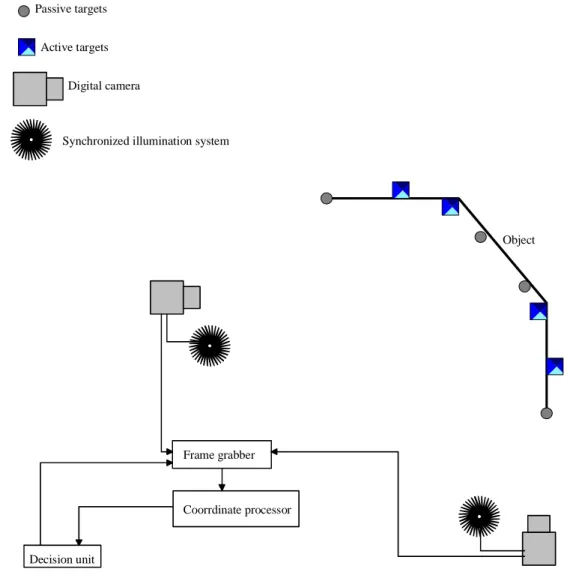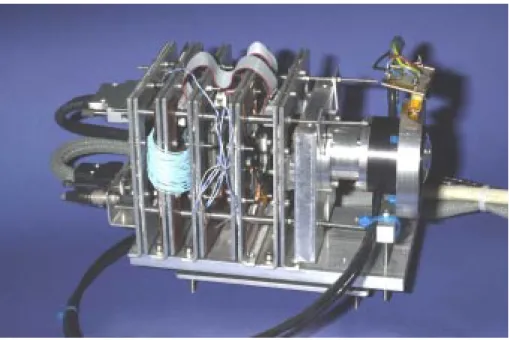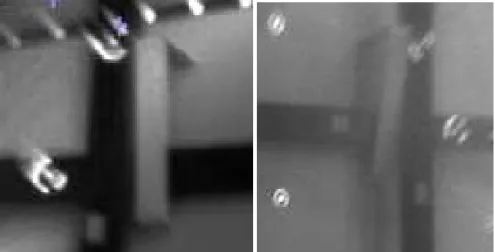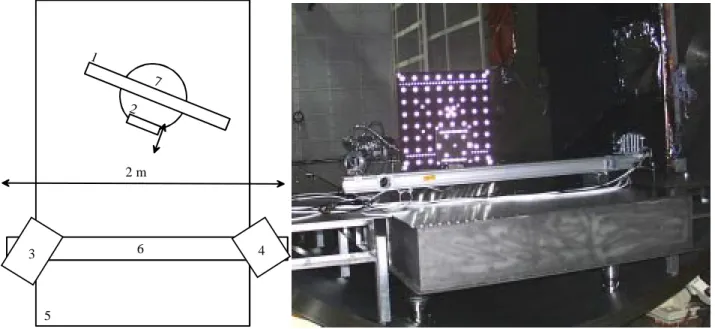Canister free videogrammetry system
for thermal vacuum and space applications
Stéphane Roose
*1, Yvan Stockman
*, Jean-Christophe Bolsée
*, Dominic Doyle
**, Gerd Ulbrich
** *Centre Spatial de Liège, Avenue du Pré-Aily, B-4031 Angleur-Liège, Belgium.
**ESTEC-European Space Agency, Keplerlaan 1, NL-2200 AG Noordwijk ZH, The Netherlands
ABSTRACT
The development of a canister-free videogrammetry system is presented. Applications in view, are co-ordinate measurements during thermal vacuum tests and on-board space flight metrology of mechanical structures, reflectors and antenna’s. The paper presents the breadboard system architecture. Two breadboards have been developed. One is based on a space-qualified micro-imager camera, and the other on an industrial camera. Lenses and flashers are all commercial components and have been made vacuum compatible. Results of accuracy (typically 50 ppm) and resolution (typically 25 ppm) tests, in ambient and in vacuum are also presented.
Keywords: Videogrammetry, thermal vacuum testing
1. INTRODUCTION
The employment of higher frequencies and increase in the dimensions of large antenna reflectors will require active compensation techniques to be compliant with evermore-stringent performance requirements. Active compensation is a two-step procedure of firstly, detection of surface distortions and secondly, correction of distortion effects on the reflector performance. Such reflectors (and their mounting structures) require also metrology systems for on-ground testing in thermal vacuum environment. In order to investigate this requirement a canister free videogrammetry system has been selected for development and bread boarding to verify the capability of measuring reflector or large structure distortions under representative thermal vacuum conditions and eventually in orbit. Structures to be measured were envisioned to have dimensions in the range of 2 to 12 m and a co-ordinate measurement accuracy of respectively 10 µ m to 100 µm was expected, corresponding to a relative dimensional error of 10 ppm. In dimensional metrology, one often uses the relative dimensional error (ε/object dimension). ε is defined here as:
ε = RSS(precision and accuracy).
In the best case, one expects that this error will be dominated by one of the two terms, such that no cumulative effects appear. Considering an error of 0.01 mm on a spatial volume of 1 m side, one obtains a relative dimensional error of 10 ppm. The use of a relative dimensional error allows making comparisons independent of the scale of the object under test. Industrial videogrammetry systems allow, in principle, to reach a 10-ppm relative dimensional error, using high-resolution cameras and dedicated optics. In addition to the metrology requirements, it is of uppermost importance to meet 3 major system level requirements for any space application of this technology:
a. Minimum mass b. Vacuum compatible
c. Survival of operational and storage, temperature excursions from -150°C to 70°C.
Two videogrammetry breadboards have been developed, one based on a space-qualified micro-imager camera and one based on an industrial camera. Lenses, flashers are all commercial components and have been modified for vacuum compatibility.
1
2. OPTICAL TECHNIQUES FOR 3-D CO-ORDINATE MEASUREMENTS
3-D co-ordinate measurement using optical techniques [1][2][3][4][5] are based on a number of fundamental methodologies, namely: Triangulation, Total Station, Tri-(or multi-)lateration and Fringe/phase measurements. eg: a. Triangulation: theodolite sighting, videogrammetry, stereoscopy.
b. Total station: time of flight (TOF) meters, interferometric meters, active triangulation distance-meters, RF modulated distance-meters.
c. Tri- (or multi-) lateration : time of flight (TOF) distance-meters, interferometric distance-meters, active triangulation distance-meters, RF modulated distance-meters, laser-camera distance-meters.
d. Fringe/phase measurement: holographic, speckle and Moiré interferometry, fringe projection.
Table 1 summarises and contrasts the essential characteristics of these various techniques. From this comparison it is clear that videogrammetry shows a lot of potentiality and maturity for automation. For general-purpose metrology applications, industrial videogrammetric systems are accurate enough. Accuracy improvements are expected with the use of larger format CCDs (8k by 8k). The technology currently used for such large format CCDs is based on a concatenation of 1k by 1k devices [6]. Videogrammetry also presents certain advantages due to previous experience already gained in applying it in thermal vacuum tests and in-orbit tests using canisters. Literature on this subject is abundant [7][8][9][10]. The possibility to easily automate the process is also an advantage. The method is not dependent on surface size or distance, neither on surface properties (diffuse, edges…) due to the use of targets for measurement point materialisation. One major drawback is ambient light perturbation, but this can be largely solved with flashlights and retro-reflective targets. Videogrammetric measurement systems can be applied in a very large spectrum of configurations, depending on the measured surface, the targets used and the illumination source. For example:
- Targets: Reflective targets, retro-reflective targets, light source targets (LED for example), no targets using software to recognize surface particularities.
- Surface: Large or small, Continuous or not, Reflective or specular.
- Light source: Flashlight, spot array projectors (covering the whole surface), no light source when background light can be used without risk of perturbation.
Total station techniques equipped with Distance Measuring Interferometers (DMI) are competitive with videogrammetry. DMI are the most accurate instruments for displacement or length determination. Nevertheless, they require a dual wavelength regime to meet this accuracy (tuneable laser) and an accurate calibration and stability of the wavelength. High accuracy rotational encoders are available for precision angular pointing determination and are probably already military-qualified. Total stations based on DMIs can provide a very good accuracy, low weight system, and insensibility to background light due to laser use. However before deployment on a space mission, further technological improvements are necessary.
Characteristic Best methods Possible methods Methods to avoid Small surface Stereoscopy Holographic, Moiré, videogrammetry,
triangulation and total station methods Large surface Total station Interferometric and TOF total station
methods, videogrammetry
Holographic, Moiré techniques, stereoscopy and triangulation Strong ambient
light
Total station Active triangulation, holographic and Moiré
techniques
Stereoscopy, videogrammetry Vibrations, surface
changes
Videogrammetry Stereoscopy, Holographic interferometry All scanning methods, holography , Moiré techniques
Surface where intrusion is possible
Videogrammetry TOF and interferometric total stations, trilateration
Theodolites, Moiré, holography
Surface where intrusion is not possible
Active triangulation total station, Moiré
Holography, videogrammetry, active
triangulation
Stereoscopy, theodolites, trilateration
Limited weight Stereoscopy Videogrammetry, Moiré techniques and holography
Trilateration, Total station
3 BREADBOARD DEMONSTRATOR ARCHITECTURE
3.1 Conceptual architecture of a videogrammetry systemThe typical hardware architecture used in videogrammetry is outlined in the following figure (Figure 1).
Passive targets
Active targets
Object Digital camera
Synchronized illumination system
Frame grabber
Coorrdinate processor
Decision unit
Figure 1. Conceptual architecture of the videogrammetry breadboard.
An object is equipped with metrology points, materialised by active (i.e. LEDs) or passive targets (i.e. retro-reflective). A number of fixed cameras, or a moving camera, view the object. The camera is synchronised with an illumination (flash) system. The cameras acquire monochrome pictures. Pictures are transferred to a frame grabber or other unit with similar function. The raw images are transferred to the co-ordinate processor (in our case a personal computer) for the data processing. The target co-ordinates are computed. The underlying physical principle, for 3-D co-ordinate retrieval is triangulation. At the breadboard level, the decision unit is the human operator. In a functional system the decision unit will be automated and will provide as output the structural form of the object under test. The decision unit can decide to perform new acquisitions, disregard measurements and even drive actuators to reshape an actively controlled surface. As mentioned above two imaging systems were bread boarded and these are described hereafter.
3.2 Micro-imaging system approach
CSEM/Space-X (Switzerland) have developed a space qualified digital micro-imager [11] based on large scale integration (volume and vertical) approach (Figure 2). The camera is designed to minimize mass, taking into account vibration stress during launch and thermal constraints during the mission [+30 to -120 ºC]. The camera characteristics are given in Table 2.
CCD TH7888A
CCD resolution 1024 x 1024 pixels
Pixel size 14 µm
Transfer mode Frame transfer Data transfer 10Mbits/s Power consumption 1.5 W
Operating temperature range -120°C to 30°C Mass including optics 110 g
Table 2. CSEM/Space-X Micro-imager characteristics.
Figure 2. The CSEM/Space-X micro imager and 70° deg optics (left ) and flash unit mounted (right). 3.2 Industrial camera system approach
The CSEM/Space-X micro-imager, does not meet the requirements of a 2k by 2k chip-camera, which can be considered as the minimum required size for high accuracy industrial videogrammetry systems. However it is “off the shelf” vacuum and space compatible. When looking at industrial CCD camera technology, only a few of them have a 2k by 2k resolution, however none of them have an architecture, which allows for operation under vacuum.
In order to evaluate a 2k by 2k camera in the breadboard demonstrator, a commercial ATMEL CAMELIA 4M camera was expressly modified (Table 3). The modifications which included replacing electrolytic capacitors, PVC cables, non-vacuum compatible connectors, conductively strapping "hot" electronic components and building a new opto-mechanical interface are standard practices in CSL (Figure 3). The disadvantage of this industrial camera based system is clearly the power consumption and the mass, which makes it less attractive for space-flight applications.
CCD TH7899M
CCD resolution 2048 x 2048 pixels
Pixel size 14 µm
Transfer mode Full Frame Data transfer 20Mbits/s Power consumption 14.5 W Operating temperature range 0°C to 50°C Mass including housing 1000 g
Table 3. ATMEL CAMELIA 4M characteristics
Figure 3. Final version of the ATMEL camera with lens and flash unit interface. 3.3 Point materialisation technology
A videogrammetry system measures 3-D co-ordinates of points that need to be materialised for visualisation and imaging. This is generally done, using luminous circular shaped targets. The system computes the co-ordinates of the centre of gravity of the targets with a centroidisation algorithm. The point materialisation has two major specifications: one is geometric and the other radiometric.
The geometric specification requires that the target will be geometrically imaged on about 5 to 10 CCD pixels (100 µm) to allow centroidisation or/and automated target recognition. For targets located at a distance, of about 5 m (1m to 10 m) the corresponding physical target size is about 20 mm (4 mm to 40 mm). The radiometric requirement is that the target point can be radiometrically “measured” by the camera head in an acceptable integration time. A full-well (100000 electrons) in a short integration time (about 1 sec) is considered. It requires therefore a strong reflectivity. The number of measurement points is in principle unlimited. The only limitations are the computer data storage capacity and the target-point density in one image. Assuming that in one image of 2k by 2k pixels a target can reasonably be identified if it is separated from another target by 32 pixels, a target point density of 4096 in one image is possible. For a 1k by 1k camera 1024 points is achievable.
a. Retro-reflective target material
Industrial videogrammetry systems supply their own targets. Most of these targets are stick-on (self-adhesive) targets based on 3M Scotchlite 7610 retro-reflective material. Although some types of targets are used in thermal vacuum none of these materials are known to be vacuum compatible or space-qualified. Recently, samples of retro-reflective materials based on an Aluminium substrate and glass-beads, have been tested in space-flight conditions [12].
b. Flash-light
In general industrial videogrammetry systems use commercial battery operated ring-light flash units. The effect of ageing of the flash-light is critical for space flight applications. The useful lifetime of a flash-light is limited to typically 1000-10000 flashes. OEM versions of ring-flash tubes and trigger electronics are manufactured by HEIMANN [13]. (Note that the HEIMANN division only caters to industrial customers.)
Our breadboards used modified commercial TOCAD SUNPAK DX-8R and SUNPAK DX-12R ring-light units. The flash tubes and the trigger electronics have been dismounted and rendered vacuum compatible flash (Figures 2 & 3). The flashlights have been tested under vacuum to check their functionality. The pressure should be lower than 1e-3 mbar to avoid spark generation on the PCB. As an additional protection, we insulated the PCB with a varnish Solithane C113. The flash light battery powered DC power supply remains outside the vacuum chamber for test purposes.
A dedicated electronic interface has been constructed to synchronize a ring-light flash unit with the CSEM/Space-X and ATMEL cameras.
3.4 Optical system
Off the shelf optics have been used for the purpose of our breadboard. A 70° deg FOV lens (Spindler and Hoyer: COM-series F#3.5 f=14 mm) was implemented on the CSEM/Space-X micro-imager (Figure 2).
For use with the ATMEL high-resolution camera a NIKON-lens NIKKOR MF f=20 mm F#2.8 was selected for its wide-angle properties. Its lens barrel was not foreseen for use in vacuum and was disassembled. CSL has redesigned and implemented a vacuum compatible barrel (Figure 3).
4. DATA PROCESSING
Videogrammetry uses 2-D pictures to compute the 3-D co-ordinates of objects. The fundamental principle used to recover the co-ordinates from the 2-D pictures is triangulation. The 2-D pictures can be interpreted as angular measurements. Videogrammetry deals with a large number of co-ordinates to be measured. The measurements are taken by means of a large number of pictures. The camera orientation is not always well identified, so that the reference frame for the 2-D pictures is unknown. In the worst case, the camera also introduces distortion. Using a calibrated camera circumvents this. Solution of the global triangulation problem cannot be made with a one shot analytic equation. Although, trigonometry and geometry are inherently and implicitly present, iterative methods are used to find the solution. This approach is generally called “bundle adjustment”. The videogrammetry data-processing flow follows a sequence as outlined here:
- Calibration of each camera [14]
- 2-D image acquisition with each camera
- 2-D target localisation with sub-pixel centroidisation
- 3-D outer orientation of camera with a Direct Linear Transform (DLT) algorithm [17] - Target identification and connection based on epipolar line theory [15]
- 3-D target localisation with a DLT algorithm
- 3-D target localisation and outer orientation with a bundle adjustment algorithm - Optional self-calibration of the cameras with an optimisation algorithm
CSL has used the commercial IMETRIC software [16], which has a processing scheme very close (nearly identical) to the processing scheme originally proposed by CSL. Bridging routines were written to allow transfer of the ATMEL and CSEM/Space-X camera pictures to the IMETRIC software for processing
.
5. SYSTEM EVALUATION
5.1 Calibration resultsThe CSEM/Space-X and ATMEL cameras were both calibrated at ambient temperatures and adjusted for a focus distance of about 1.5 m. The self calibration routine was applied to both cameras on an array of points covering the whole field. The resulting calibration polynomials were used as initial values in the course of all the following experiments.
An important outcome of this calibration process is the residual error of the image-point co-ordinates.
The first estimate for the residuals in the image-points was about 0.3 µm for the CSEM/Space-X camera and 0.4 µm for the ATMEL camera. The result of the calibration gave 0.45 µm for the CSEM/Space-X camera and 0.55 µm for the ATMEL camera, which corresponds to respectively 1/30-th and 1/25-th of a CCD pixels.
In some of later experiments, where a lot of field points were lying on the edge of the field of view we reach about 1.5
µm or 1/9-th of a CCD pixel. This lower quality is an effect of the field aberrations of the lenses, which degrade the image point quality at the edge of the field (Figure 4), but this effect is smeared over all the points in the bundle adjustment process.
Figure 4. Examples of degraded image quality at the edge of the camera fields. 5.2 Ambient test
The system has been tested under ambient conditions for various configurations and types of targets: (a) multiple objects with a moving object in the scene mounted on high resolution translation stage (Figure 5a), and (b) a large vacuum vessel lid (2 m diameter) simulating a reflector (Figure 5b).
The RMS-error is given for the co-ordinates along the 3 orthogonal axes (Table 4). The RSS of the RMS is also given. Calibration scale-bars have been used as check-points. A solid body distortion in the scene, was simulated buy a moving plate (Figure 5a) up to an amplitude of 200 ppm. In Table 4 ∆x, ∆y, ∆z represents the difference between the videogrammetry measurement and the nominal displacement as measured electro-mechanically.
Multiple objects (Figure 5a) RMS x RMS y RMS z RSS Scalebar error ∆ x-moving plate ∆ y-moving plate ∆ z-moving plate Micro-Imager 26 ppm 30 ppm 56 ppm 69 ppm 15 ppm 15 ppm 14 ppm 15 ppm 2-m object (Figure 5b) RMS x RMS y RMS z RSS Scalebar error Industrial camera 11 ppm 10 ppm 17 ppm 22 ppm 12 ppm Micro-Imager 33 ppm 35 ppm 60 ppm 75 ppm 19 ppm
Table 4. Sample summary results of the videogrammetry test with both systems, showing the RMS of the 3-D co-ordinates, the RSS and the absolute accuracy on the scale bar measurements
These results show that an accuracy of typically 50 ppm and a resolution better than 25 ppm were achievable.
Figure 5. Target distribution for (a) a multiple object scene and (b) a large object (2 m diameter). 5.2 Vacuum test
The objective of this test was the qualification of the videogrammetry system operating under vacuum conditions. The metrology performance test used a reference plate, which was placed in the field of view of the cameras. The temperature of the targets during the test was about 293°K. As in the ambient test a small moving plate was used to simulate out of plane distortions. All experiments were done with retro-reflective targets.
The reference plate was mounted on a rotation stage in the vacuum chamber. The two cameras visualise the reference plate simultaneously. They take pictures of the reference plate at different angles (0 arcdeg, 30 arcdeg, 60 arcdeg in azimuth and a fixed elevation angle of about 0 arcdeg) (Figure 6).
5 3 6 4 1 2 7 2 m
Figure 6. 3-D metrology test set-up: (1) Plate with retro-reflective targets, (2) Small moving plate, (3) CSEM/Space-X camera, (4) ATMEL camera, (5) optical bench, (6) Supporting rail located at 1 m from object, (7) Rotating stage.
Given the field of view of the cameras, it was possible to visualise the whole scene for cameras located at 2 m from the object. Lateral separation of the cameras was about 2 m.
The X-Y plane lies in the large plate. The Z-axis is perpendicular to the large plate. The movement of the small plate is parallel to the Z-axis. Both cameras and flash-lights operated correctly without failure at pressures below 5 10-5 mbar.
Figure 7. Typical pictures from the micro-imager (left) and industrial camera (right) during the vacuum test phase. The pictures show also the points identified by the IMETRICS software.
During both the ambient test phase (atmospheric pressure) and vacuum phase (5 10-5 mbar) three sets of measurements (A, B, C) of the reference plate were made and compared with respect to an earlier measurement. This allowed establishing the stability of the calibration of the camera’s under vacuum. For the micro-imager a self-calibration procedure was used. The accuracy of the retrieved 3-D co-ordinates of the targets with respect to the prior reference measurement are presented in Tables 5 and 6.
Industrial camera RMS x RMS y RMS z RSS Ambient A 7 ppm 11 ppm 28 ppm 31 ppm Ambient B 11 ppm 15 ppm 31 ppm 36 ppm Ambient C 10 ppm 17 ppm 31 ppm 37 ppm Vacuum A 7 ppm 17 ppm 33 ppm 38 ppm Vacuum B 8 ppm 17 ppm 37 ppm 41 ppm Vacuum C 11 ppm 17 ppm 39 ppm 44 ppm
Table 5. Accuracy stability of the industrial camera based videogrammetry system in ambient and vacuum
Micro-Imager camera RMS x RMS y RMS z RSS Ambient A 20 ppm 20 ppm 49 ppm 57 ppm Ambient B 17 ppm 21 ppm 47 ppm 53 ppm Ambient C 19 ppm 21 ppm 47 ppm 56 ppm Vacuum A 19 ppm 22 ppm 51 ppm 54 ppm Vacuum B 19 ppm 21 ppm 49 ppm 56 ppm Vacuum C 19 ppm 20 ppm 49 ppm 56 ppm
Table 6. Accuracy stability of the micro-imager based videogrammetry system in ambient and vacuum
A final test applied to both systems, was to check their resolution, by measurement of an out-of plane displacement of the plate. Nominal displacement values are A-B = 500 ppm and A-C = 250 ppm. Plate displacement measurements differences with respect to the nominal values are given in Table 7.
Plate displacements A-B A-C
Micro-imager-vacuum 7 ppm 9 ppm
Micro-imager –ambient 7 ppm 17 ppm
Industrial camera-vacuum 10 ppm 9 ppm Industrial camera-ambient 10 ppm 15 ppm
Table 7. Resolution of the industrial camera and micro-imager based videogrammetry systems in ambient and vacuum
It was possible to determine small displacements with a resolution better than about 15 ppm.
6. CONCLUSIONS
Two breadboard videogrammetry systems have been developed and tested under ambient and vacuum conditions. These systems are unique because they are canister free, in contrast to existing industrial videogrammetry systems used in space-borne and vacuum test applications. One system used a 1k x 1k CCD space qualified micro-imager camera. The other breadboard is based on a specially modified industrial high resolution (2k x 2k CCD) camera and is more representative of the performance necessary for ground based thermal vacuum tests. The micro-imager based system achieved a relative dimensional error figure of between 40 and 80 ppm, while the higher resolution system achieved figures of between 20 and 40 ppm.
Due to the prototype nature of the hardware developed certain shortcomings were inherent. However valuable lessons have been learned from this exercise and are listed here:
1. The design of a dedicated optics having low distortion and no field aberrations is mandatory for high performance digital videogrammetry. Most commercial lenses are, in addition, inadequate for space or thermal-vacuum application, due to the lens barrel construction.. With such generic optics the effective resolution of the imaging CCD can be significantly compromised.
2. High resolution cameras are essential in order to achieve a 10 ppm accuracy figure. It was clearly evident that the higher resolution camera (2k by 2k) achieved systematically better accuracy performance compared to the micro-image camera (1k by 1k) because of its greater number of pixels and therefore larger imaging format. A typical factor of 1.5 to 2 improvement in accuracy was observed between the two cameras (for the same pixel size).
3. We have demonstrated that it is possible to design and implement a vacuum compatible videogrammetry system. However vacuum capability forces the user to live with certain geometrical constraints. This will also be the case with space flight 3-D metrology systems on board vehicles with fixed structures and limited resource allocations. We observed that geometrical constraints can degrade the accuracy by a factor 1.5 or 2.5 over an otherwise optimised configuration (of identical hardware).
It remains a considerable challenge to achieve a relative dimensional error of 10 ppm for digital videgrammetry. Nevertheless point displacement resolution of 10 ppm has been clearly demonstrated under specific conditions.
ACKNOWLEDGEMENTS
This work presented in this paper was performed under contract to the European Space Agency (ESA), Ref. GSTP 14283/00/NL/WK.
REFERENCES
[1]
F. Chen et al, “Overview of three-dimensional shape measurement using optical methods”, Op. Eng. 39, 10 (2000). [2] A. W. Burney et al. "Comparison of three optical methods for measuring model deformation", Proceedings of the38th Aerospace Science Meeting & Exhibit, AIAA-2000-0835, (2000).
[3] W.T.Estler et al. "Large scale metrology-An update", Annals CIRP 51/2; (2002). [4] N.A. Massie et al., “Absolute Distance Interferometry”, Proc. SPIE 816, 149 (1987).
[5] H.U. Frey, “Holography-A successful tool for distortion measurements on antennas under space simulation conditions”, ESA SP-304, 395 (1990).
[6] www.dalsa.com
[7] N. Nikolaizig et al., “High accuracy photogrammetric system for large space simulator at ESTEC”, ESA SP-304, 409 (1990).
[8] J. Bouman et al., “A photogrammetry system for use in thermal vacuum testing”, ESA Bulletin 81 (1990).
[9] P. Baussart et al, "Videogrammetry applied to environmental testing for space programmes", ESA SP-467, (2001). [10] Bruce A. Conway, “NASA Programs in Advanced Sensors and Measurement Technology for Aeronautical
Applications”. NASA Langley Research Center. ICAS-90-2.2.1.
[11] J.L. Josset et al, “Digital 1 k x 1 k micro-imager for planetary surface exploration”, Proceedings of the 2nd Round Table on Micro-Nano Technologies for Space, 15-17 October 1997 ESA/ESTEC, Noordwijk, The Netherlands. [12] L.M. Lucier et al. "Ground based testing of atomic oxygen effects on a candidate retro-reflective target material for
space vision system", ESA SP-467 (2001).
[13] Perkin-Elmer, "Heimann opto-flashtubes catalogue", (2002).
[14] H. Beyer, “Accurate calibration of CCD-cameras”, IEEE Computer vision and Pattern Recognition, 96 (1992). [15] R. Horaud , Olivier Monga., “Vision par ordinateur: outils fondamentaux”, Editions Hermes (1995).
[16] www.imetric.com
